Porifera - PowerPoint PPT Presentation
1 / 17
Title:
Porifera
Description:
Sponge structure. Review key parts... No tissues, organs or body systems! ... NOTE: Nudibranch predators co-opt sponge defenses (toxins, spicules) ... – PowerPoint PPT presentation
Number of Views:58
Avg rating:3.0/5.0
Title: Porifera
1
Lecture 2
- Porifera Cnidaria
2
Phylum Porifera The sponges
3
Evolutionary relationships
- Why or Porifera considered animals rather than
Protists? - How do they differ from other animals (3 ways)?
4
(No Transcript)
5
Sponge structure
- Review key parts
- No tissues, organs or body systems!
6
Water movement and feeding choanocyte, Fig. 33.4
- Role of flagellum
- Role of collar
- Movement of particles
- Phagocytosis
7
Amoebocytes
- Move in amoeboid fashion through mesohyle
- Secrete spicules and/or spongin
- finish digestion
- Garbage-collector cells
- Transport waste to excurrent pore
- Can develop into other cell types
- Somewhat like stem cells!
8
Protection
- Sponges are sessile
- Toxins/warning coloration
- Painful or sharp covering (spicules)
- Regenerative ability
- Camouflage (if not toxic)
- Bore into shells.
- NOTE Nudibranch predators co-opt sponge
defenses (toxins, spicules)
9
Nudibranch (Phylum Mollusca, Class Gastropoda)
10
Phylum Cnidaria
Scyphozoa
Anthozoa
Hydrozoa
Cubozoa
11
Phylum Cnidaria
12
Evolutionary relationships
13
Radiata vs. Bilateria
14
Body organization
15
Key features
- Polyps and medusae
- Two germ tissue layers (called..?)
- Mesoglia
- Gastrovascular cavity (functions?)
- Nervous system nerve net
- Neurons? Brain? Nerve cords (bundles of axons)?
- Tentacles with cnidocytes (stinging cells)
16
Cnidocytes/nematocystsHow do they work?
17
Life-history strategies































